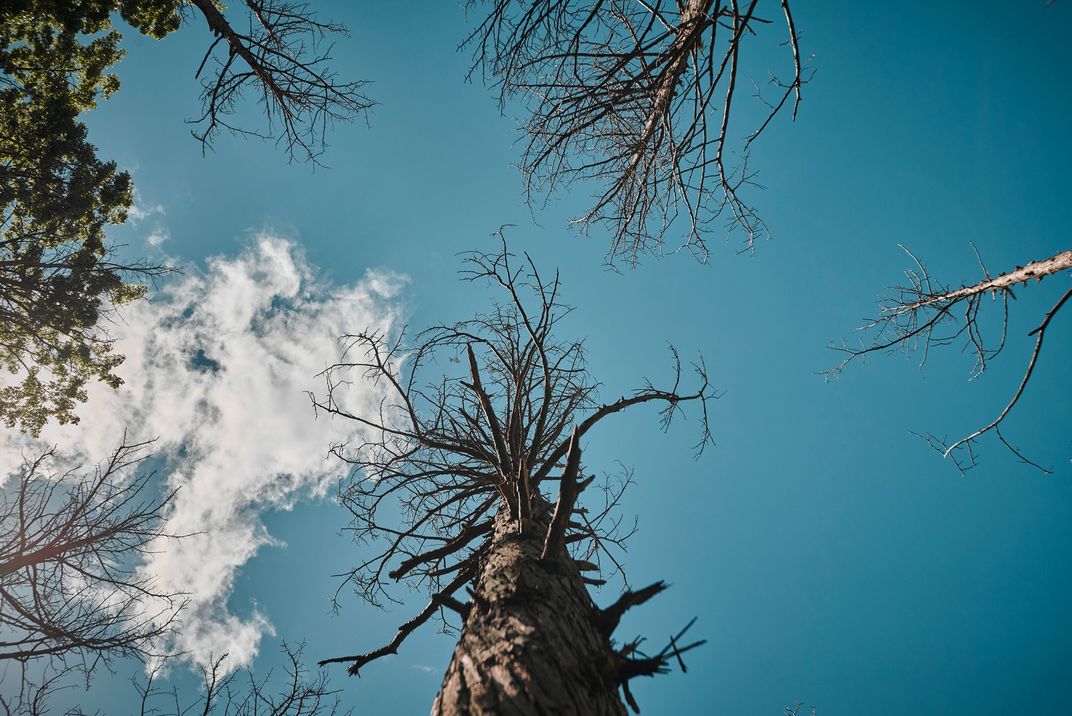Haunting ‘Ghost Forest’ Resurrected in New York City
Artist Maya Lin hopes to call attention to one of the dire effects of climate change with an installation in Madison Square Park
Editor's Note, May 18, 2021: Maya Lin’s “long-delayed but ultimately triumphant” Ghost Forest installation debuted in New York City last week, writes Jonathan Hilburg for the Architect’s Newspaper. Originally slated to open last summer, the display of 49 transplanted Atlantic cedars references the climate change–fueled ecological phenomenon of the same name.
As Lin said at the exhibition’s opening, Ghost Forest has taken on added resonance due to the Covid-19 pandemic. “You can’t not think or look at these in a different way than a year ago. That does become part of the piece,” she explained, per Artnet News’ Sarah Cascone. “There is a sense of mourning.”
The artist added, “There is a parallel between a global pandemic and climate change which is also a global threat to humanity. By 2100, 50 percent of all species may go extinct due to climate change.”
Read our November 2019 article about the project below.
When the weather warms, New York’s Madison Square Park transforms into a verdant oasis tucked away in one of the city’s busiest districts. Flowers bloom, lawns turn green and a canopy of leafy trees provides shade. Come this June, however, visitors will encounter a jarring sight amid the bustling park: a tall grove of spindly dead cedar trees.
As Maxwell Williams reports for Artnet News, the trees are set to be transported to Madison Square Park for a new installation by artist Maya Lin. The work, titled Ghost Forest after a term used to describe mass die-offs of trees linked with rising sea levels, will stand “as a grave reminder of the consequences of inaction to the climate crisis,” says Brooke Kamin Rapaport, deputy director and Martin Friedman chief curator of the Madison Square Park Conservancy, in a statement.
Lin is known for creating evocative works of art that prompt profound reflections among viewers. In 1981, the then-21-year-old Yale graduate student beat out more than 1,400 applicants in a competition to design the Vietnam Veterans Memorial in Washington, D.C. Lin’s creation—constituting two black granite walls sunk into the ground and inscribed with the names of more than 58,000 Americans soldiers killed during the conflict—remains a striking fixture on the National Mall
Over the course of her long career, Lin’s art has focused on humans’ engagement with physical landscapes. Climate change advocacy is the driving force behind many of her recent works, including “What is Missing?,” a digital “global memorial to the planet” that seeks to raise awareness about the loss of species and habitats around the world. Users can click through text, videos and photographs that juxtapose the planet’s declining biodiversity with promising conservation efforts.
“I am going to try to wake you up to things that are missing that you are not even aware are disappearing,” Lin told Yale Environment 360’s Diane Toomey in a 2012 interview. “If I can get you to look at something afresh, maybe you will pay closer attention.”
For this latest project, Lin collaborated with Madison Square Park Conservancy to source dead Atlantic Cedars from the Pine Barrens in New Jersey—one of many sites along the mid-Atlantic coast where trees have been killed by exposure to seawater.
When sea levels rise—a dire phenomenon caused by climate change—saltwater mingles with freshwater river systems and aquifers, “creating a brackish mix that chokes out the vegetation rooted in the ground above,” reports Michael Sol Warren of NJ.com.
Extreme weather events like Hurricane Sandy, which struck the Atlantic coast in 2012, can hasten die-offs by pushing seawater far up the river system; the cedars in Pine Barrens, according to the Conservancy, were “afflicted by extreme salinization.” Scientists say that as the planet continues to warm, hurricanes are likely to become more intense and damaging.
Ghost Forest’s June debut will be accompanied by a series of public programs, lectures and events that highlight the challenges of the climate crisis and explore possible ways to address it. Some 60,000 people pass through Madison Square Park each day, the Conservancy notes; Lin’s installation seeks to call these individuals’ attention to one dire indicator of our planet’s failing health.
“I want to pull this stark image into the middle of Manhattan where everything is very green,” the artist tells Robin Pogrebin of the New York Times. “There is something emotionally ghostly about walking through one of these forests.”
/https://tf-cmsv2-smithsonianmag-media.s3.amazonaws.com/filer/29/00/290088bb-fa7f-4b0d-a666-a872470f77f5/copy-of-4_credit-maya-lin-studio.jpeg)
/https://tf-cmsv2-smithsonianmag-media.s3.amazonaws.com/filer/8d/33/8d335c37-ad52-4374-b42c-d8fcf3c4dab4/andy-romer_copy-of-mspc_springviews_042021_0213.jpeg)


